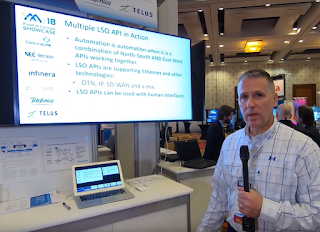Networking innovation will be even more important in the next 10 years than what we’ve seen to date, said Amin Vahdat, Google Fellow, in a keynote at the ONF Connect event in Santa Clara, California.
The key reason for this is the ever-increasing pace of data growth, which Vahdat says is clearly outpacing the growth of compute resources. This becomes a problem when you are delivering information-rich web pages with data streaming from multiple sources. Developers need to couple resources from many places. Vahdat is charged with building a better network, one which can be updated more frequently.
Google, which probably runs the biggest networks in the world, was an early mover in SDN and all of its infrastructure is now software-defined.
Google's public network now has over 100 PoPs worldwide (blue dots on the map) where it exchanges traffic with other networks. The company is rapidly deploying servers (yellow dots) with partner ISPs to improve content delivery. The company claims its share of the global Internet continues to grow. Its private network is actually bigger and growing even faster.

As for day-to-day operations, Vahdat said Google's infrastructure is under constant attack. A key principle is to catalog every failure, and to use this knowledge to develop new features in the network. This means a rapid pace of iteration in the network.

https://www.opennetworking.org/onf-connect/
The key reason for this is the ever-increasing pace of data growth, which Vahdat says is clearly outpacing the growth of compute resources. This becomes a problem when you are delivering information-rich web pages with data streaming from multiple sources. Developers need to couple resources from many places. Vahdat is charged with building a better network, one which can be updated more frequently.
Google, which probably runs the biggest networks in the world, was an early mover in SDN and all of its infrastructure is now software-defined.
Google's public network now has over 100 PoPs worldwide (blue dots on the map) where it exchanges traffic with other networks. The company is rapidly deploying servers (yellow dots) with partner ISPs to improve content delivery. The company claims its share of the global Internet continues to grow. Its private network is actually bigger and growing even faster.

As for day-to-day operations, Vahdat said Google's infrastructure is under constant attack. A key principle is to catalog every failure, and to use this knowledge to develop new features in the network. This means a rapid pace of iteration in the network.

https://www.opennetworking.org/onf-connect/






















